If you are unsure how to help your anxious child, this guide will give you an overview of how the brain impacts your child’s anxiety and tips to help them manage anxious feelings with your support!
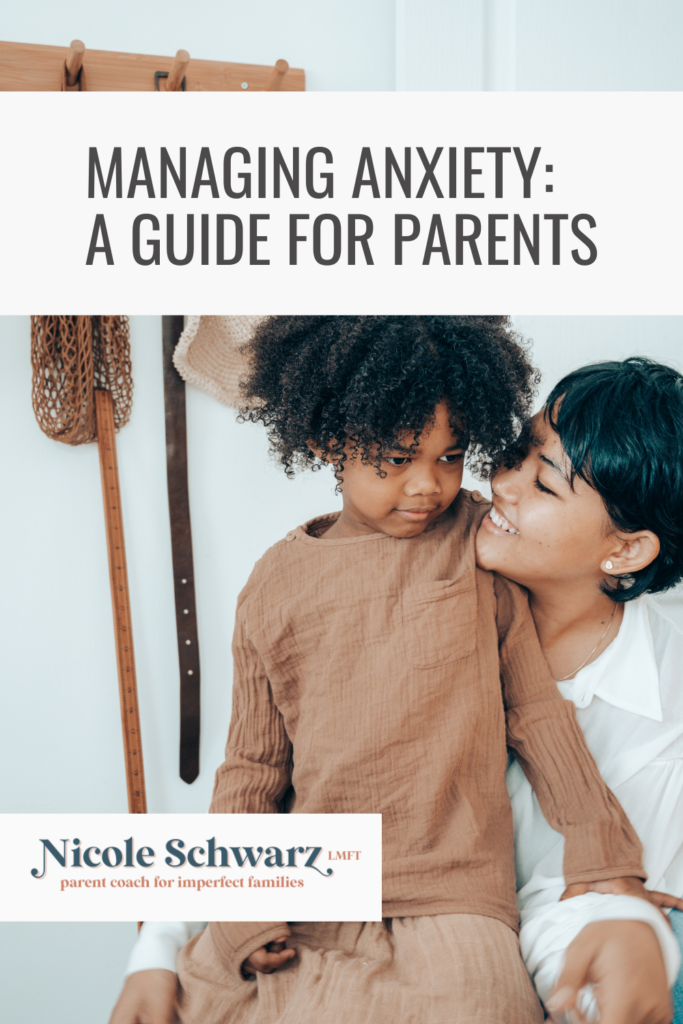
Sometimes anxiety is a tiny nagging voice in the back of your mind asking, “did you turn off the oven before you left the house this morning?”
Sometimes, anxiety is a loud bullhorn pressed directly to your ear yelling, “you cannot handle this situation! I repeat! We are not prepared for what’s to come!”
In small amounts, anxiety can be beneficial. It can move you forward, it can help you work harder towards a goal.
But most of the time, anxiety is an unhelpful intruder.
And, the worst part is, you can’t just make it stop by “trying harder” not to be anxious.
If you struggle with anxiety in any form or intensity, you are not alone!
A few caveats:
Before we can talk about how to help our kids learn to identify and manage their anxiety, we need to focus on our own anxious tendencies.
All of the suggestions below can be used by children and adults. Though, if you are just starting to learn how to manage your anxious feelings, it may be best for you to start practicing these strategies yourself before you introduce them to your kids. Give yourself time and space to try these ideas on for size. See what you like and what you didn’t. See where you get stuck and what seemed to help.
As always, you do not need to do this on your own! One of the best ways you can overcome anxiety is by reaching out for support. The information provided below is not a substitute for mental health therapy. Finding a therapist, talking with your doctor, or opening up to friends may be the best next step for you!
Managing Anxiety: It Starts With You
For many adults, these anxious tendencies have been with us for decades.
This way of being in the world is hard-wired.
Changing these thoughts and patterns will take time, patience, and practice. With each step forward, you may see a few steps back. And that’s OK!
Celebrating “small” wins, honoring each deep breath, and offering yourself compassion is essential.
You are more than your anxious thoughts.
And you are worthy of this kindness!
Remember: You cannot shame yourself out of anxiety. You can’t just “get over it” because you want to. No amount of beating yourself up will make a positive impact.
Understanding your brain
Your brain does a lot of amazing things, but one of the most important tasks is to keep you alive and safe. It is constantly scanning your environment for potential threats. When a threat is detected, your brain and body will respond in one of four ways: fight, flight, freeze, or faun.
In “fight,” you may feel a surge of adrenaline, your muscles may tense, you may increase your heart rate, and you may clench your fists or your jaw.
In “flight,” you may look for an escape, you may actually leave the room, you may want to hide, and you may do what you can to avoid a task or a conversation.
In “freeze,” you may stand completely still, you may be unable to speak, you may feel the blood drain from your face, and your fingers may feel numb.
In “faun,” you may have an overwhelming urge to give in, please the other person, or do what you can to make them happy.
These reactions happen in the blink of an eye.
There are times when these reactions do keep you safe! The “fight” response may get you to the curb before your toddler, keeping them from running into oncoming traffic.
While your brain takes its job seriously, it is not always accurate at detecting threats.
Let’s say you mispronounced a word when you were reading out loud in 3rd grade. Your brain may file that experience away. The next time you get up to read out loud in front of the class, it may trigger a threat response, “Ahhhh! Remember last time? You were so embarrassed. I will not let you feel that way again.” *sounds the panic alarm*
You start to feel sick to your stomach. You can’t focus on the words. Your breathing gets shallow.
Suddenly, your brain and body see reading out loud in front of the class as a threat.
What started as a way of protecting you can snowball into a full-blown fear of public speaking.
Of course, this is an extremely simplified example of a complex brain/body response, but I share it for a few reasons:
- I want you to know that you are normal. Whatever reaction you have is OK.
- Sometimes we grow up in environments where danger and threats are real. And sometimes, our brain overreacts and sees small mistakes or difficult situations as threats.
- Recognizing your brain and body’s response in a situation is an important first step.
- You are not stuck! There are things you can do to help retrain your brain.
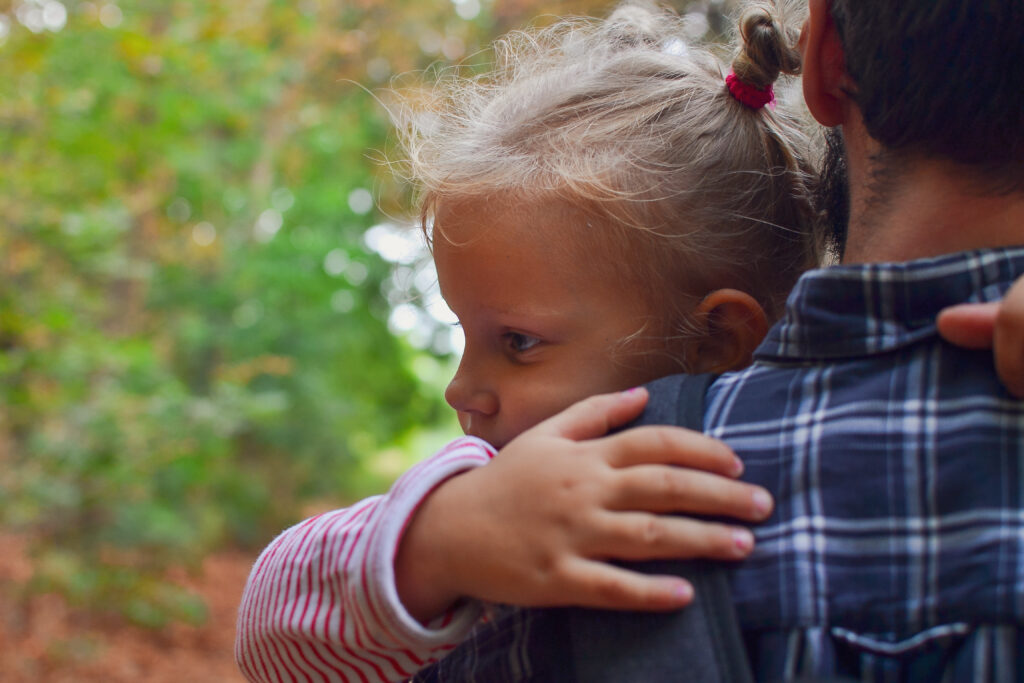
Anxiety & Your Child
Sometimes, reactions and behavior fall neatly into one of those four categories. And sometimes behavior will come out of the blue, leaving us feeling confused.
Anxiety in kids can show up as: talking about monsters in the closet, hiding behind your legs at social events, or biting fingernails.
But anxiety can also look very different.
Your child may avoid certain foods, have a meltdown if you run out of peanut butter, refuse to go to bed, pick on their brother, say their homework is stupid, make repetitive noises, forget directions, and seem to “check out” in certain situations or conversations.
Rather than saying, “I’m worried that I might make a mistake at my piano lesson today,” your child may say that they have a stomachache.
Instead of expressing, “I feel alone and afraid at night,” your child might run around the hallway, avoiding your many requests to “get in the bathroom and brush your teeth!”
Not every behavior is anxiety-related, but it’s important to be curious.
Before you assume your child is being disrespectful or defiant, it may be helpful to ask yourself: could this behavior be a fight/flight/freeze/faun response?
Notice Anxious Feelings
Now that you know how a brain and body may respond when anxiety pops up, you can start to notice.
Again, we want to notice without judgment or shame.
This is simply your brain doing the best it can to keep you safe. It’s not a character flaw or something you are doing wrong.
(For some people noticing is helpful, for other people, noticing makes them feel more anxious. This is just one way to combat anxiety, and it may not be the best option for you or your child. Take good care of yourself by skipping any suggestions that are not a good fit.)
Here’s one way to add “noticing” into your routine:
Set an alarm for 4 or 5 random times throughout the day.
When the alarm goes off, pause. Breathe.
Scan your body from head to toe. How do your shoulders feel? How are you breathing? What about your heart rate?
Then, think about what’s going on in your day, your environment. What circumstances, conversations, or situations may be impacting how your body feels right now?
If it’s helpful, you can rank how you feel from 1-5, 1 being “calm” and 5 being “extremely anxious.” (Or use a ranking that works better for you.)
For kids, it may be helpful to draw a rough outline of a person and have them use different colors to show how their body feels and where they feel different emotions.
You may be able to label how you feel and you may not. Your child may be able to name what’s happening in their body and they may not. Either way, it’s OK! You and your child can build an emotional vocabulary over time.
Name Your Anxiety
Feeling anxious can feel powerless – like being carried away by a wave of emotion. Rather than avoiding or ignoring these anxious feelings, regain some control by naming them.
Help your child imagine that these anxious feelings and thoughts actually live outside of them.
What does anxiety look like? Is it a big green blob? Is it a grizzly bear? Is it a tiny gnat?
Can your child draw it? What color is it? How big? What does it sound like? What words does it use?
Next, ask, “What would you like to call it?”
The name can be anything: Worry bug. Big-annoying-green-blob-guy. Mr. Yucky. Whatever!
Now that you have an image and a name, you can help your child practice talking to their anxiety in this form.
When they feel the urge to rip up their math worksheet, help them direct the conversation to their anxiety:
“I hear you Mr. Yucky. Yeah, yeah. Math isn’t my favorite. Thanks for reminding me! (insert eye roll here) But guess what? I’m going to take my time, and I’m getting help, so I don’t need you bugging me. Bye-bye!”
Or when they feel alone on the playground, “Buzz off, Zelda. I see my friend on the swings, so I’m going to talk to her.”
Or when they feel stuck in a negative thought, “Ahhhh! I’ve had enough of you bossing me around! I’m in charge now. Get back to your stinky swamp!”
Personalizing the word “anxiety” can remind kids that they are not “bad” for feeling this way. This is not a flaw or defect. It’s something that they can manage – with your help!
Breathe Through Anxious Moments
One of the simplest strategies for overcoming anxious thoughts is breathing.
It can also feel like the most difficult strategy!
If you struggle to pause and take a deep breath, you’re not alone! Remember, your brain and body are preparing for a threat (real or imagined), and deep, relaxing breathing is the last thing you need in a stressful situation!
So, for now, let it be a work in progress.
If your child refuses to take a deep breath, don’t force it. It’s OK to build this skill over time.
Rather than waiting for the heat of the moment, build deep breathing into your daily routine.
A deep breath comes from the belly, not the chest. To practice this, have your child lie on the floor or on a bed. Place a stuffed animal on their tummy. Experiment with different breathing patterns until they are able to find a way to lift the stuffed animal up and down slowly, giving them a “ride.”
After they’ve mastered breathing on the floor, you can practice taking a deep breath while standing. Have your child put their hands on their belly and see if they can move in and out like they did on the floor.
(It’s not easy! Keep practicing!)
If you’re ready to advance, you can practice breathing in slowly, holding, and exhaling slowly. Some people count to 4 or 8, while others like to just focus on slowing down the inhale and exhale.
Be Mindful
Anxiety likes to keep us firmly in the past or the future. Reminding you of all the things that went wrong or areas you’ve failed, or keeping you panicked about not being able to manage whatever comes next!
Staying in the present moment is difficult. So many things compete for our focus!
Building mindfulness practices into your daily routine will make it easier for you – or your child – to shift out of the anxious thoughts and into the here and now.
Two mindfulness practices to try:
5-4-3-2-1
Name 5 things you see. 4 things you hear. 3 things you feel. 2 things you smell. 1 thing you taste.
Colors of the Rainbow
Look around your room, and find something red. Orange. Yellow. Green. Blue. Purple. (Add more colors if your child’s favorite color isn’t in the rainbow.)
If those activities still feel a bit too much in an anxious moment, do what you can to feel your feet on the ground or your body in a chair. You may try saying, “My feet are firmly on the ground.” or “I feel the chair under my legs.”
You don’t need to know what to do next or have a plan for attacking your anxiety, the goal in this moment is to be present. To give your body a second to reset and to remind yourself that you are no longer in the past and that you have the skills to manage what’s to come in the future.
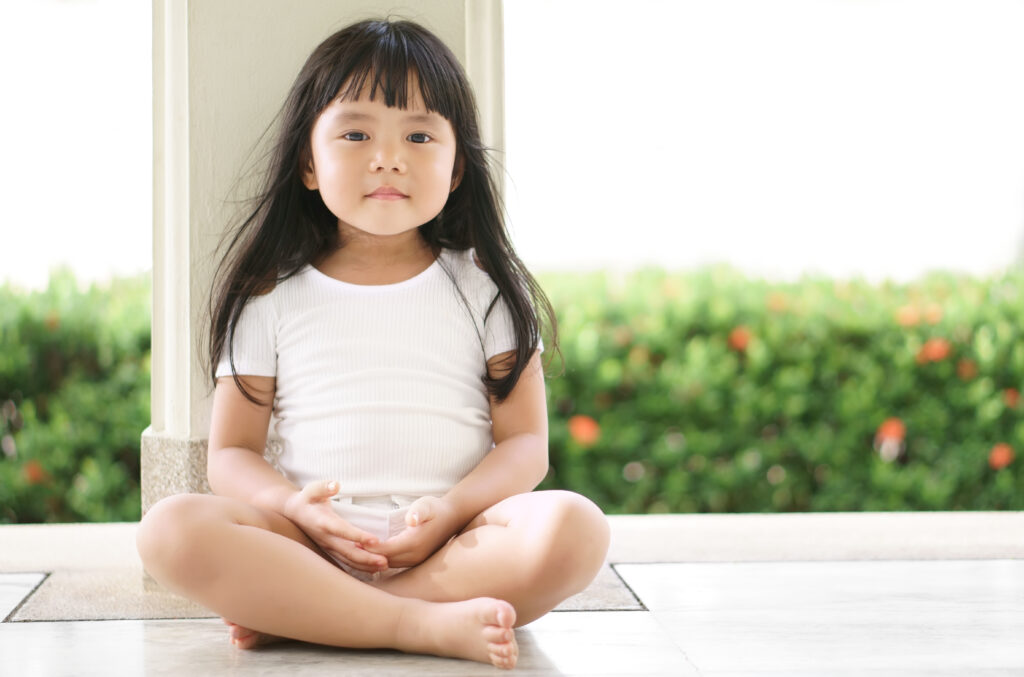
Parenting an Anxious Child: Cushion and Pushing
Managing anxiety will look different for each of us – and for each of our kids.
If you push your child to do something before they are ready, it may backfire, causing them to be even more resistant in the future. But, if you never expect them to overcome difficult tasks, their anxiety can continue to grow, keeping them stuck!
The goal is to find opportunities to help your child overcome feelings of anxiety while also providing them with lots of love and support. Author Tina Payne Bryson calls this, “cushion and pushin’.”
You can provide “cushion” by letting your child know they are not alone and that feeling anxious does not mean there is something wrong with them. “Cushion” may look like you staying in the gym during their first gymnastics class. Or, it may mean that you talk about what to expect before a friend’s birthday party.
Your “cushion” can also come after a difficult experience. Sitting with your child, listening, cuddling, and letting them know that they are safe.
You can provide “pushin'” by telling them, “I am going to wait in the waiting area during your gymnastics class today. I can’t wait to see you after!” Or by saying, “I’m not sure what kind of cake they are serving. Once you find out, you can decide if you want to eat it or not.”
Sometimes, the best “pushin'” comes when we project our own confidence. When our kids experience us feeling OK about a situation, they often feel more capable.
Finding the balance between cushion and pushin’ is an imperfect and often messy process.
Rather than trying to get it “right,” focus more on proactive strategies like breathing and mindfulness. Be curious about your child’s unique personality and what they need to take the next baby step toward overcoming feelings of anxiety.
If you’d like more coping strategies, check out my friend Janine Halloran’s website: copingskillsforkids.com
Yeah but…
What if you do all of these things and it’s still really hard?
Sometimes, you cannot – and should not – do it on your own. Sometimes, we cannot be our child’s parent and their therapist. Sometimes our own triggers and anxieties get in the way of helping our kids.
It doesn’t mean you’re failing or doing something wrong.
Seeking help from a mental health professional is a good and important next step.
If you don’t know where to start, ask your pediatrician, a teacher, or a school counselor for referrals. If the people they recommend are not taking new clients, ask them for referrals or get on their waiting list.
Therapists who work with kids use games, art, and play to help them express emotions and learn coping skills. Some therapists work with the child independently, and some therapists include parents and entire families in the sessions. Finding someone you and your child feel comfortable with is an important part of this process.
Reflection questions:
- Can you think of a time your body responded in fight/flight/freeze/faun?
- What would you call your anxiety? How would it look?
- What is one small way you can add mindfulness to your day?

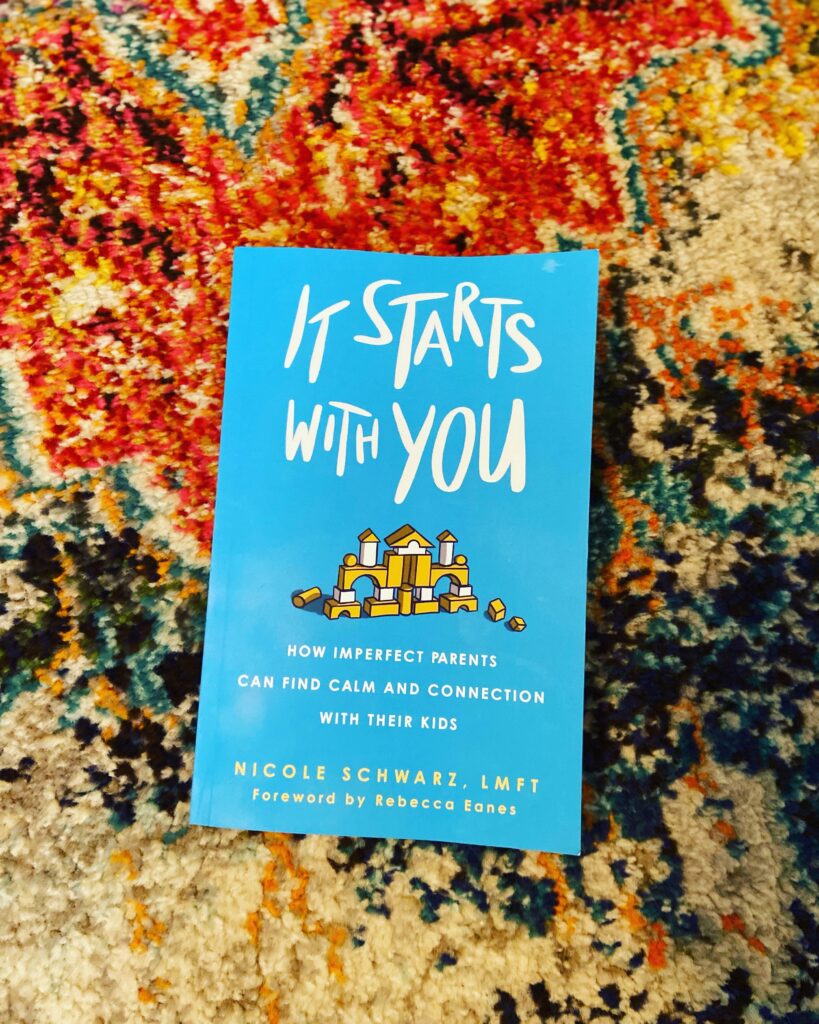

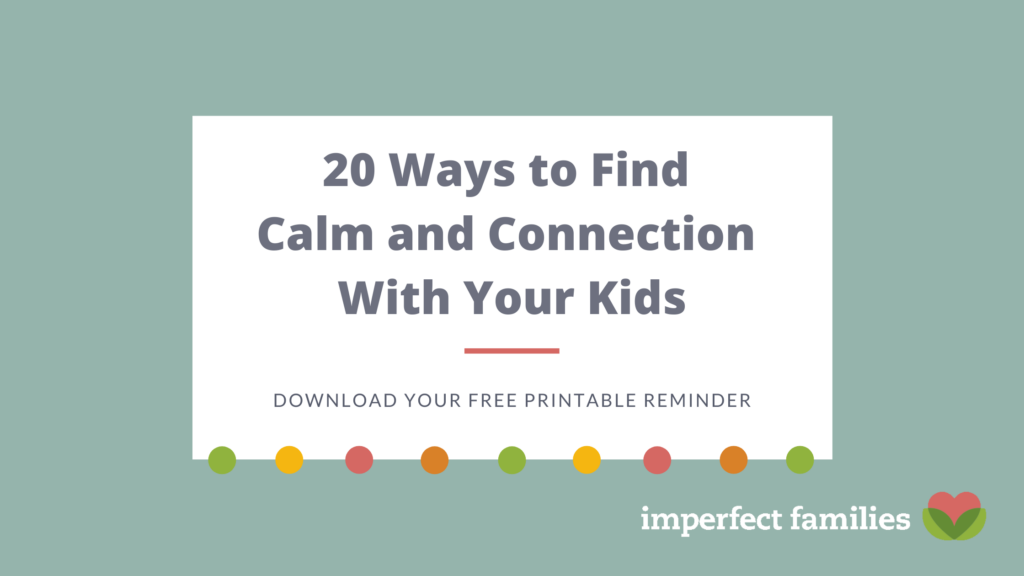
Comments have been turned off to retain the privacy of all families. If you have a question or comment on the topic, you're always welcome to contact me.